- Here
is a summary of those aspects in the Agamas that apply directly to temple
management and are most relevant today.
Author compares how governments manage Hindu temples today, and how kings did
in the medieval times, suggesting some solutions to the situation today.
These
detailed manuals cover everything from how to build temples to the worship
rituals and every aspect of practical management
A marvelous new
book has been published on temple management, based on the scriptures that
govern temples. At right is a review of the whole book, and below is a summary
of those aspects that apply directly to temple management and are most relevant
today.
Hinduism regards the siva temple as the embodiment of God. The garbhagriha, or sanctum, of the temple is Siva’s head. His lotus feet are at the magnificent entry tower, to which we bow before stepping in. The holiness of the temple springs from the idea that it is the body of the Divine, to be treated with the utmost sanctity, purity and respect. It is not God’s home. It is God Himself.
Hindus believe the Agama scriptures originated from the five faces of God, Siva, at the time of creation. While Vedas are general, lyrical and symbolic, the Agamas focus on specifics, with devotional worship at their heart. They are rich in details of how to locate, design, build, worship, manage and maintain a temple. Agamas, like the Vedas, are part of the vast Hindu shruti (“that which is heard”) - the authoritative scriptures.
Books
on Hinduism written by non-practitioners use a Western, and mostly Abrahamic,
lens to analyze the tradition. Generally they aim to find fault with Hinduism,
not understanding or caring about its subtle, profound philosophy. A recent
book published by the Indic Academy, Temple Management in the Agamas with
Special Reference to Kamika Agama, is much different. Its author, Dr. Deepa
Duraiswamy, looks at the Agamas from a deep Hindu perspective.
This article was
first published in Hinduism Today.
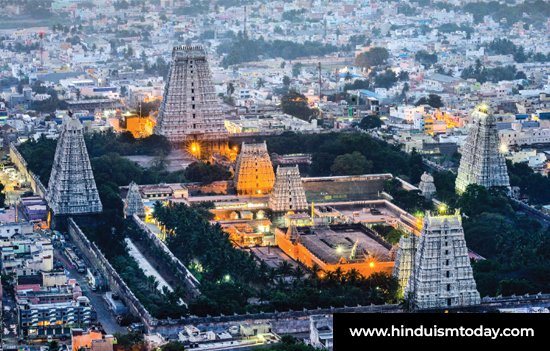 The huge Annamalaiyar Siva Temple in Tiruvannamalai, Tamil Nadu has hundreds of staff. Chris l Jones/Dinodia
The huge Annamalaiyar Siva Temple in Tiruvannamalai, Tamil Nadu has hundreds of staff. Chris l Jones/Dinodia
Dr.
Duraiswamy comes from a long lineage of Saiva priests. She grew up in a home
next to the ancient Siva temple of Thirumazhisai, near Chennai in Tamil Nadu.
As a young girl, she followed her learned grandfather all around the temple.
The divine structure enchanted her in all its beauty and grandeur. Little did
she know that one day she would return as an adult to study that same
temple.
After studying engineering in Pune, she earned a management degree at the Indian Institute of Management in Calcutta. All the time, she had a strong desire to study the Agamas and understand the world of her forefathers. For her doctoral thesis, she decided to analyze the
management of the temple as described in the Kamika Agama, hoping
her research would bridge the world of tradition and modernity. Her book
fulfills that hope and provides valuable insights into the inner workings of
the temple.
When
the Agamas were written, the kings managed the temples; today in
India it is most often the local state government. In Tamil Nadu, for instance,
over 40,000 temples, including most major ones, are under government
control through the Tamil Nadu Hindu Religious and Charitable Endowments
Department. This interference with Hindu temples by a supposedly secular
government - which has made no corresponding attempt to control the religious
institutions of Christianity and Islam - is a thorny issue within the Hindu
community. There have been egregious examples of corruption in the temple
finances and usurpation of endowment lands belonging to the temples.
Dr. Duraiswamy’s study compares how governments manage Hindu temples today, and how kings did in the medieval times, suggesting some solutions to the situation today.
A Great Hindu Institution
Temples
are great institutions, and they have traditionally been central to Indian
life. Historians note that every big village in ancient India featured an
ornate temple at the center. While it is hard to date, the first temple
appeared in India at least 2,500 years ago. This was not only a place of
worship. It filled a large place in the cultural and economic life of the
people. Thanks to its all-encompassing nature, the
temple was the largest employer in town. Multiple priests, florists,
musicians, gardeners, cooks and sculptors worked for the temple. Tenant farmers
earned a living tilling its lands. Temples built water reservoirs and canals.
Studies show that temples were economic magnets, drawing groups of people from
afar to settle nearby and benefit from the opportunities temples created.
Today,
in most places, the temple remains an important social, cultural and economic
center. It is a living tradition that still draws hundreds of thousands of
devotees seeking the unique experience of divinity and spirituality offered by
the temple. The systems and structures which support this experience make a
temple an organization with its own management needs, and it is from this
perspective the book is written.
A Modern Business Analysis
Duraiswamy categorizes the temple as what we now call a “knowledge
industry.” Its workers need specialized abilities, skills and training to make it a holy, welcoming place. The Agamas enumerate in detail the human and physical resources required to make the temple function correctly. The author steps through these resources systematically, pointing out areas where the present government management falls short.
After her general introduction to Saivite religion and temples, Duraiswamy explains in detail the Agamic temple system, beginning in Chapter Two, “Worship Schedule of a Saiva Temple.” She starts with a point people often overlook: the primary duty of a temple is to conduct worship for the
welfare of the world. In Karana Agama, an important Saiva Agama, two
types of puja are described: atmartha puja (for one’s self) and the parartha puja
(for the community). Individuals offer the former at home for their own
protection and the latter at temples for the benefit of all living beings.
Devotees come to the temple to worship as part of a scheduled puja, and at other times to “have darshan,” that is, sight, of the Deity. They will also do devotional singing, chant the names of God, walk around the temple clockwise (pradakshina) and meditate.
The
most important activity in a temple is nitya puja,
the daily worship, comprising rituals offered in a particular sequence and
format. This is done for God, whether devotees are present or not. It is the
reason a temple exists. The nitya puja is a set of rituals in which the priest
invites and treats God as a guest.
The rites closely resemble the reception extended to an esteemed guest. Agamas lay down rules for ritual bathing, decoration, food offering and other services. Worship is also offered for other Deities in the temple, for certain events, and at the request of devotees. The temple’s annual festival involves the entire community and attracts people from far-off places.
The meaning of the Sanskrit word nitya is two-fold: daily and also eternal. As a public institution, a temple “needs to function irrespective of if there are visitors or not,” Duraiswamy states. The temple’s schedule must revolve around the Deity and not around the devotees. Many devotees and temple administrators, she points out, seem to act as if temples exist for the devotees - and to collect donations. This excessive focus on revenue started in British times, when they found themselves in charge of temples after displacing the king, and still dominates the minds of many government-appointed temple administrators.
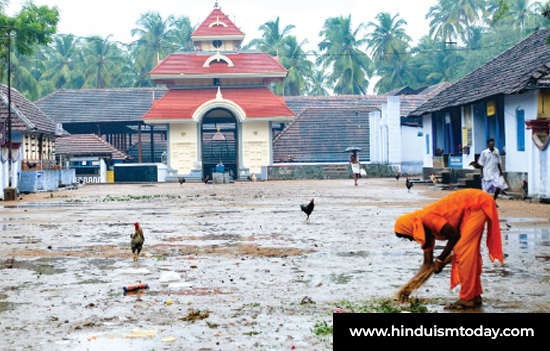 The never-ending
job of cleaning up. M. Amirtham/Dinodia
The never-ending
job of cleaning up. M. Amirtham/Dinodia
The Temple Workforce
In Chapter Three, on staffing, Duraiswamy points out that the present common nomenclature - the government “officials” and the “servants,” meaning the priests and their assistants - does not reveal the nature of the services the priests perform, nor does it match the traditional view of the temple milieu. For instance, in the Agamas the acharya
is the head priest, the functional and spiritual head of the temple, who hires
other priests and assigns their work. In Pallava times, the priests and others
who served at the temples were considered a family.
The
modern temple administration, however, divides temple staff into two classes,
officers and servants. The latter - including the Acharya - are employees whom
the government can hire or fire at will. The very functioning of the temple has
been skewed and distorted by this subservience of the Acharya - the spiritual
and moral center of the temple - to the finance-oriented chief administrative
officer.
Duraiswamy
cites a 10th-century inscription from Chola times that lists 63 staff positions at one particular Durga temple.
There was one acharya, four assistants, nine musicians, 24 dancers, two garland
makers, three watchmen, one accountant, one potter, one washerman, one
astrologer, one carpenter, one administrator and some families to grow
flowers.
In
the bigger temples in Tamil Nadu, according to historical records, several
priests took turns conducting the main worship. These large temples also
employed oduvars (devotional singers) and maintained spiritual
theaters where various drama troupes performed.
As
the book points out, the traditional temple workforce could be described as a
pyramid, with the Deity at the top, then those who performed the core worship,
their immediate helpers, secondary worship helpers, material supply,
maintenance and administrative support. Most temples raised cows and hired
families to care for them. The Agamas also gave the artisans - architects, masons, sculptors, carpenters- important
roles to play.
 Silpi at working carving a Ganesha statue for worship. Madhusudan Tawde/Dinodia. Preparing sweet laddu offerings at Tirupati Temple.
Silpi at working carving a Ganesha statue for worship. Madhusudan Tawde/Dinodia. Preparing sweet laddu offerings at Tirupati Temple.
The Agamas divide
priests into five categories - acharya, archaka (performs
puja), sadhaka (worship
assistant), alankruta (decorator),
and vachaka (chanter).
Musicians, managers, and other temple staff had specific titles based on their
specialization. They were not employees in the typical sense.
Each was in the service of God and had a special relationship
with the Deity.
The Deity and their interdependence bound them together. Even the managerial
roles in the temple were authoritative only to ensure that all who served at
the temple got their rightful share.
The Agamas categorize
temple staff based on whether they received a salary. Housekeeping and the
managerial staff got a monthly salary. That mode of payment did not work well
for priests, because of the nature of their service. The Agamas say
that the spirit behind remunerating an acharya is one of honoring and seeing
that he is satisfied. This is where the concept
of dakshina or honorary payment had its origin. Land or grain grants satisfied the basic economic needs of the priests and others at temple service. In an agrarian economy where bartering was the predominant system of trading, this arrangement worked very well.
Honoring a priest for his service with gold, clothes and other
valuables is what the Agamas recommend. This system broke down as
India became poorer after centuries of looting by the foreign invaders. People
started giving whatever they could and whatever they pleased as payment to the
priests. This led to generations of poorly paid priests, high in learning but
living in abject poverty.
Despite
this, thousands of priests continued to serve at the village temples, as they
do to this day. They all believed serving the Deity was their God-given duty,
regardless of the money they made. Until recently, most youth from priestly
families did not take up other jobs. Even when the rest of the family migrated
to cities seeking better prospects, one member would remain in the village to
continue worship at the temple.
Temple Management Under the Kings
A chapter titled “The Role of Administration” analyzes how kings in India managed temples. Many rulers built grand temples as part of their legacy. When they won new territories, kings worshiped the resident Deity to please the locals. The temples themselves, however, remained politically neutral.
The Agamas ask
the ruler of the land (not any specific king) to protect and support the
temple. He is prescribed several duties: preserving the sanctity of the temple, protecting its tradition, giving resources and preserving and maintaining the temple structure. The king must enforce the temple rights to its land endowments. It is the king’s duty to collect the temple’s portion of the harvest and distribute it among the eligible people.
It was the king’s responsibility to appoint a learned chief priest at the time of initial consecration of a new temple starting a hereditary succession. The king was also to ensure the temple performed all rituals at the right time using the right materials. It was his duty to see that the special festivals were conducted appropriately and the cleanliness, sanctity and purity of the temple premises maintained. Likewise, the king was to keep the temple adequately supplied with the various materials and instruments for worship.
Other principal responsibilities of the king included providing funds to the temple (either directly or through endowments), safeguarding the Deity and the temple structure from enemies, burglars and vandals, auditing the temple’s finances and resolving disputes related to its earnings.
Epigraphic sources quoted in the book indicate these Agamic injunctions were closely followed in medieval times. The Agamas considered the Deity a living entity and the temple as His house. Just as a business owner would have an agent, so did the Deity. In Siva temples, Lord Chandeshvara (bit.ly/Chandeshvara) was the lawful agent of Siva, the proprietor. The medieval temples conducted purchase, lease or sale of temple land and other financial matters in Chandeshvara’s name. In modern times, such transactions are in the name of the presiding Deity, whom the courts regard as a legal “person.”
The king ensured the temple received regular income from
properties it held as endowments. People who illegally occupied temple
land or swindled its money faced penalties. This stands in stark contrast to
the current state of affairs in India. Hindu groups allege that governments
routinely close their eyes to the thousands of cases of temple land
encroachment. Some governments, specifically the ones in Tamil Nadu, Andhra
Pradesh and Kerala, seem to be in a rush to sell off temple lands and jewellery.
Many Hindus believe a fierce anti-Hindu bias is behind these moves, as
governments do not touch properties belonging to other religions.
Transition to Modern Times
The fifth, last and most important chapter of the book is titled “Current Management Practice.” It opens by recounting that the rulers of the Vijayanagar Empire were the last major royal patrons of temples in southern India. After Bahmani sultans defeated the empire and demolished its capital city in 1565, several regional rulers patronized temples not destroyed by the invaders.
When
the British usurped power from these local rulers, they looked upon temples as
lucrative sources of revenue. First, in 1925, they took control of large
temples. Amidst protests from Hindu leaders, they established the Hindu
Religious and Charitable Endowments Board to oversee Hindu religious places. In
1942, a non-official committee recommended that the board should come under
government administration.
Ironically, after independence in 1951, India’s federal government continued the temple takeover by passing the Hindu Religious and Charitable Endowments Act. Then, in 1959, the state of Tamil Nadu enacted its own Hindu Religious and Charitable Endowments Act and established the HR&CE department.
Today,
more than 40,000 temples, including 56 Hindu monasteries, 1,910 endowments and
17 Jain temples, are administered by the Tamil Nadu government, with complete
control of their finances and land holdings. No Muslim (5.86% of the population)
or Christian (6.12%) religious institutions come under government control in
any state in India.
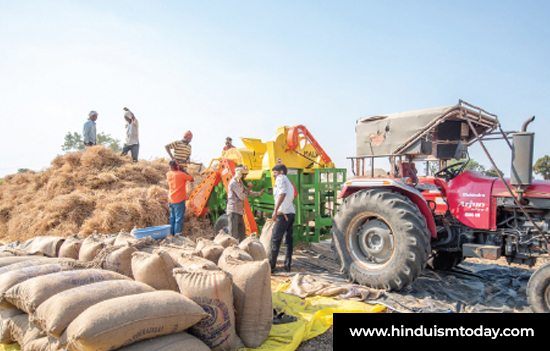 The local temple whose land these farmers work gets a share of the harvest. Shutterstock
The local temple whose land these farmers work gets a share of the harvest. Shutterstock
In the United States, for one example, it would be unthinkable for a government - state or federal - to control any religious institution. This makes it difficult to explain the situation in India to Americans, as they simply can’t believe such a thing possible.
Hindu
religious institutions in Tamil Nadu fall into four categories based on their
reported revenue. With annual revenue exceeding us$13,300, 182 temples
feature in the first category. Earning between $2,660 but less than $13,300,
498 temples fall into the second group. The third category has 3,331 temples
with an income of $133 to $2,660. Temples with less than $133 income, 34,470 of
them, are in the last group. Officers of different grades manage these temples.
An officer with the government rank of joint commissioner heads the biggest and
richest ones.
The HR&CE department in Tamil Nadu appoints two members to the Board of Trustees of each major temple. This has been controversial. Andhra Pradesh governments, including the present one, have even appointed non-Hindus to the Tirumala Tirupati Venkateshwara Devasthanam Trust Board. This is believed to be the world’s richest Hindu temple, with an annual income of $160 million. This government meddling in temple affairs has angered adherents. It reflects the mindset of micromanaging a few temples with high income and neglecting the rest.
The temples’ collective budget in Tamil Nadu for the year 2012-13 comprised a corpus fund of $16.6 million, created using the funds from big temples. Public contribution of about $1.06 million, a one-time government grant of $8 million and a yearly renovation grant of $4 million made up the rest of the budget. The board spent only about $10.9 million in that year. Many people allege the government receives tens of millions if not hundreds of millions of dollars from the temples but never discloses the actual amount collected.
The Temple Worshipers Society, based in Chennai, has pointed out that temples in Tamil Nadu own almost 500,000 acres of agricultural and other lands, plus 22,000 buildings and 33,000 commercial and home sites. From all of these, the HR&CE department collects just $7.5 million per year. If the government were to collect all monies due the temple, the income should exceed $8.08 billion. The society also states, “between 1986 and 2005 people have encroached over 47,000 acres of temple land and over 10 million square feet of plots belonging to Hindu temples.”
The book presents four case studies, three from Tamil Nadu and
one from the US. These give some fascinating data about the current state of temple management. Dr. Duraiswami herself studied Manonukulesvara Temple in Thirumazhisai, Amrtaghatesvara Temple in Tirukadaiyur and Arunachaleswara Temple in Tiruvannamalai. All follow the Kamika Agama.
The Manonukulesvara Temple follows a twice-a-day worship schedule and employs seven people, including the chief priest. Both Amrtaghatesvara and the Arunachaleswara temples follow a six-times-a-day worship schedule and have 55 and over 200 workers, respectively. They also receive many visitors each day, and the money received in their collection boxes is an important component of their income.
A
telling fact comes out of these case studies. Priests and cooks receive a
monthly honorarium of $13 to $39, while guards at the temple make $240 to $266
a month. This extremely low pay is the major issue
temple priests face today. Some priests have not even received pay for
years. This poverty forces the worship staff to look for ways to increase their
income to feed their families and discourages the next generation from
continuing their traditional occupation.
To
understand the temple dynamics, the author sought input from the priests. Their
reports clearly pointed to their stifling monetary condition. Only a tiny
number of priests in large urban temples flourish. Thousands of others live in
poverty. The author points out that the general spirit of the traditional
Adisaiva community is to honor Siva as their family elder and continue worship.
Under current conditions, though, the younger generation could become
disillusioned and turn to better-paying professions.
The Agamas sanction
and encourage the concept of dakshina - an amount given directly to the
priest by the devotee in gratitude for his services. Several temples managed by
the Tamil Nadu HR&CE department now carry a board in prominent places
telling devotees not to offer money to the priests. Such an instruction from
the government to the public demeans and disempowers the priests and hurts them
deeply. It belittles the roles they play and demoralizes them. The temple
singers, musicians and sculptors testify to a similar picture of poverty and
disrespect. As a result, the younger generations of these communities are
losing interest in their traditional occupations.
Collecting rental dues from temple properties and reclaiming
lands from encroachers is a key step to improving the financial situation of
temples and their employees. The author urges people to realize that meals,
marriages and other benefits that temples offer come from money the temples
themselves collect. They are not freebies from the government. Dr. Duraiswamy
says the perception that the secular government spends its money on Hindu
temples is wrong. Governments spend only a small portion of the income they get
from temples on these social programs.
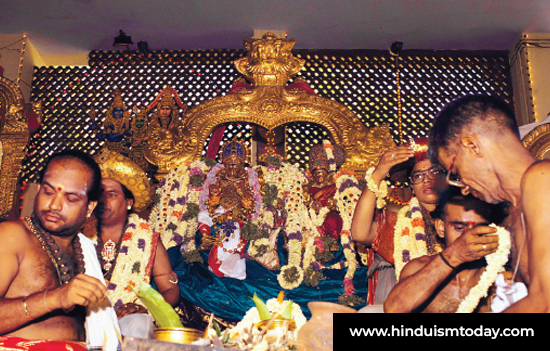 Madurai Meenakshi priests with the parade Deities. Rupinder Khullar/Dinodia
Madurai Meenakshi priests with the parade Deities. Rupinder Khullar/Dinodia
Recommendations for the Future
The author makes several specific recommendations for the future. First, instead of looking only at their revenue, she suggests we should use size, number of Deities, antiquity and historical value to classify temples. To help temples with little local income, she proposes pooling resources and allocating money where needed. This would help ancient and great temples with low revenue, allowing at least one daily puja at all temples. She advises that governments shed their “maximize revenue” approach and adopt a holistic management perspective to prioritize the temple’s benefit to the community.
The
book makes a strong point that in every temple, worship must happen at least
three times a day - morning, noon and evening. The priests need years of
initiation; musicians and singers require extensive training. The government
and Hindu society as a whole should recognize and respect their traditional
learning.
Temples must run teaching centers to teach time-tested spiritual
values to the public.
Discourses, stories, meditation, yoga and bhajan at temples help people lead a
virtuous life. Every temple should have a calendar of spiritual events to
engage the community.
The Vedas and Agamas contain
a wealth of wisdom. Temples must study and spread this insight by establishing
research and resource centers. Programs to help the surrounding communities
will make temples the pivotal social centers they once were.
History
shows that art advanced as temples developed. Temples must hire artisans to
further develop the unique genre of temple art. Temple-run cultural centers,
where experts in various arts and crafts can gather, work, perform, and share
their ideas, can nurture the communities around them.
Preserving
temple structures, sculptures, inscriptions, paintings and murals is an
investment made to protect our future. All repair, restoration, or enhancement
work must follow a well-crafted standard to safeguard the antiquity and
architecture of the temple. A study is needed to map the temple workforce by
profession, based on their education and training.
Dr.
Duraiswamy writes that we can manage temples better with the help of a database
of their name, location, antiquity, size, and name and number of Deities.
Temple tanks, towers, artwork, worship schedule and annual budget could all be
included. Disclosing full information on funds collected and spent and
displaying this in all temples would increase transparency and public
involvement.
The quality and precision of the worship must take precedence in the evaluation of the managerial staff. Then only should be considered the daily income, collection of rental dues, reclamation of encroached land, protection of the temple and its traditions—all of which support the worship. Rituals, singing of traditional Tamil devotional songs, music, dance, garland-making, cooking—all these are unique skills temples need. Lack of resources and apathy have caused decay in these disciplines.
The
current governments seek to legitimize their control of temples by saying they
are simply replacing the kings. But any entity replacing the kings must have
devotion to the Agamas and the temple. We need a similar environment
today for temples to thrive.
No temple administrator should ever be appointed who does not believe in temple worship. Administrators must have faith in worship’s beneficial impact on the universe and respect people who serve and visit the temple. They must understand and appreciate the Agamas and should preserve and protect the temple tradition.
The
current legal standpoint is that management of temples is a secular function,
rather than religious. This approach starkly
contradicts Agamic prescriptions. As matters stand today, anyone who is not a Hindu, or who merely declares himself a Hindu, can be appointed to administer Hindu temples. This must change. People who are not Hindus and who do not believe in temple worship should not be in the temple’s workforce. Surely, as the author clearly states, nobody can imagine that someone with no faith in the Deity would follow the Agamas or protect the temple.
In Conclusion
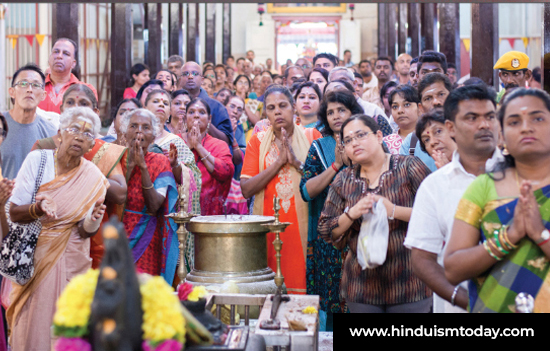 Devotees absorb the profound vibrations of the worship at Nattukotai Chettiar Temple in Malaysia. Shutterstock
Devotees absorb the profound vibrations of the worship at Nattukotai Chettiar Temple in Malaysia. Shutterstock
Dr. Deepa Duraiswamy urges people to adopt temples in their areas. It is essential that community members volunteer to help during special events and festivals and participate in the temple’s administration and upkeep. She hopes people who believe in Hinduism and respect its traditions will study Agamas, as there is a need for several in-depth studies. Thousands of beautiful temples around us are reminders of our glorious past. They also are pointers to endless possibilities to make our future equally bright and noble. The supreme dedication and sacrifice made historically and still today by priests, sculptors, musicians, artists, singers and other workers to build and protect our temples must inspire us to act.
Vidyasagar
Tontalapur, a journalist turned software engineer, lives in Superior, Colorado.
He is deeply interested in Sanathan Dharma, technology and its impact on
society.
This
article was first published in Hinduism Today and Here
eSamskriti has obtained permission from Hinduism Today to share.
To
read How Hindu Temples came under Government control
To read all
articles on Indian Culture